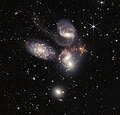Файл:Stephan's Quintet taken by James Webb Space Telescope.jpg
Перейти до навігації
Перейти до пошуку

Розмір при попередньому перегляді: 625 × 599 пікселів. Інші роздільності: 250 × 240 пікселів | 501 × 480 пікселів | 801 × 768 пікселів | 1068 × 1024 пікселів | 2136 × 2048 пікселів | 12 654 × 12 132 пікселів.
Повна роздільність (12 654 × 12 132 пікселів, розмір файлу: 63,39 МБ, MIME-тип: image/jpeg)
Історія файлу
Клацніть на дату/час, щоб переглянути, як тоді виглядав файл.
| Дата/час | Мініатюра | Розмір об'єкта | Користувач | Коментар | |
|---|---|---|---|---|---|
| поточний | 17:33, 12 липня 2022 |  | 12 654 × 12 132 (63,39 МБ) | Habitator terrae | c:User:Rillke/bigChunkedUpload.js: |
| 15:55, 12 липня 2022 |  | 3500 × 3355 (4,94 МБ) | Yitzilitt | Uploaded a work by NASA from https://www.nasa.gov/image-feature/goddard/2022/nasa-s-webb-sheds-light-on-galaxy-evolution-black-holes with UploadWizard |
Використання файлу
Такі сторінки використовують цей файл:
Глобальне використання файлу
Цей файл використовують такі інші вікі:
- Використання в af.wikipedia.org
- Використання в bn.wikipedia.org
- Використання в de.wikipedia.org
- Використання в en.wikipedia.org
- Використання в en.wikiquote.org
- Використання в fa.wikipedia.org
- Використання в fi.wikipedia.org
- Використання в fr.wikipedia.org
- Використання в he.wikipedia.org
- Використання в hu.wikipedia.org
- Використання в is.wikipedia.org
- Використання в it.wikipedia.org
- Використання в ja.wikipedia.org
- Використання в ka.wikipedia.org
- Використання в ko.wikipedia.org
- Використання в kw.wikipedia.org
- Використання в ml.wikipedia.org
- Використання в ms.wikipedia.org
- Використання в no.wikipedia.org
- Використання в pl.wikipedia.org
- Використання в pt.wikipedia.org
- Використання в ro.wikipedia.org
- Використання в te.wikipedia.org
- Використання в tr.wikipedia.org
- Використання в zh.wikipedia.org




